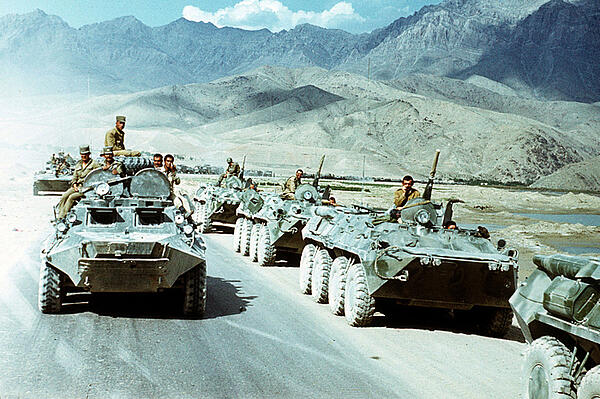Russian Invasion of Afghanistan
The Russian invasion of Afghanistan happened in 1979, starting a war that lasted for ten years. In December, paratroopers from the Soviet Union landed in Afghani capital of Kabul, which had already been decimated by a civil war in the country.
Afghanistan had had a communist government since April 1978, when the Saur Revolution took place. The Communist Party of Afghanistan (PDPA) seized power and formed a government under Nur Muhammad Taraki. In September 1979, Taraki was himself overthrown and killed by another Communist, Hafizullah Amin.
Whilst in power, the Afghan Communist party, supported by the USSR, attempted to replace or simply ignore many Afghan traditions and religious values. They announced equality of the sexes and allowed women to enter the world of politics. They also changed the Afghan flag, which was an Islamic green, to a red flag based on that of the Soviet Union. This angered many people in Afghanistan.

Many Muslim leaders were arrested; others made the decision to flee the capital and instead escape into the mountains. Amin in particular gained a reputation for ruthlessness. He ordered the assassination of his predecessor, Tarazu, and he is thought to have been responsible for thousands of politically motivated executions.
In response to the Russian invasion and new government approach, thousands of Afghani Muslims decided to join the Mujahideen, which is a guerrilla force led by warlords that wanted to overthrow the Amin government. The Mujahideen declared a jihad (a holy war) on Amin and his supporters.
In December 1979 the Soviets invaded Afghanistan to try and put an end to the civil war and stabilise the communist government. Soviet forces reportedly shot Amin and in turn replaced him with Babrak Karmal. Karmal was propped up by Soviet military support but this was under serious threat; by this time a large number of Afghan soldiers had deserted to join the Mujahideen and as a result the Kamal government found itself outnumber, needing roughly 85,000 Soviet soldiers to maintain its power.
Unsurprisingly, due to the size of its forces, the Mujahideen was a very difficult for Kamal to overcome. Moreover, while their weapons were inferior - they would typically use old rifles - they were far better accustomed to the Afghan terrain, including the mountains around Kabul. Soviet army boots fell apart in the harsh mountain terrain and Soviet tanks were of little use in the mountain passes. The Soviets were in a similar situation to that of the Americans in Vietnam. They resorted to extreme measures - they used helicopters, poison gas and napalm to try defeat the Mujahideen.
By 1982 it is estimated that the Mujahideen controlled 75 per cent of Afghanistan, even though they were battling against the second most powerful military force in the world. Many Soviet soldiers deserted to the Mujahideen.
The USSR gained no support for the invasion. Indeed it had been condemned by the UN as early as 1980 but the organisation’s call for Soviet forces to withdraw were vetoed - by Russia!
The USA also made its opposition to the invasion clear for all to see; the country banned the grain from being exported to Russia, while it also stopped the SALT talks and boycotted the 1980 Olympic Games, which were held in Moscow. That’s not all - keen to stop communism from spreading any further, the USA also gave Mujahideen fighters access to American surface-to-air missiles, although this was done indirectly. Ultimately though, the USA identified that Russia was fighting a losing battle - much as it had done in Vietnam.
Mikhail Gorbachev eventually withdrew the USSR from Afghanistan upon the realisation of what other leaders had been too scared to admit in public: this was a war that the USSR simply could not win. All the while the cost of attempting to defeat the Mujahideen in Afghanistan was seriously damaging its already fragile economy.
The withdrawal began on 15 May 1988 and was completed by 15 February 1989. Soviet Forces had lost 14,453 troops during the conflict; Afghan Forces had lost 18,000 men. The Mujahideen lost approximately 75,000-90,000 men. Estimates of civilian deaths range from 850,000 to 1,500,000. Millions of Afghan citizens fled the country as refugees.
MLA Citation/Reference
"Russian Invasion of Afghanistan". HistoryLearning.com. 2025. Web.
